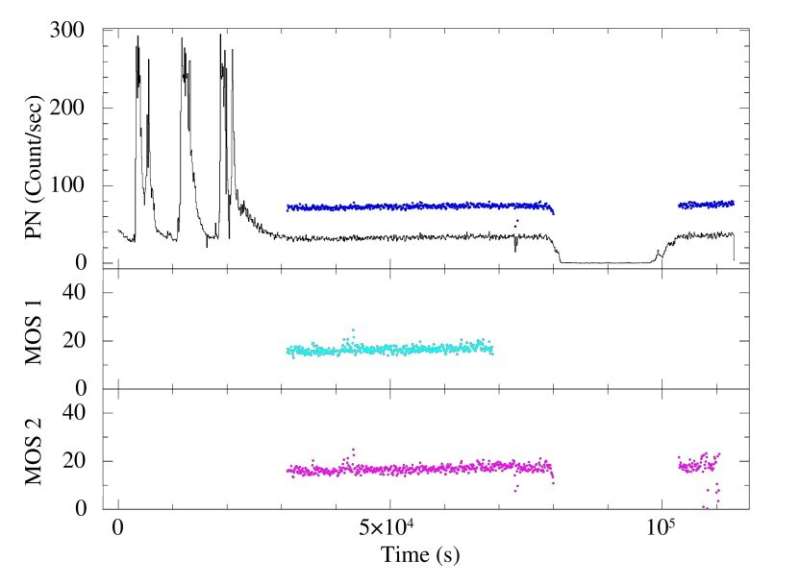XMM-Newton EPIC light curve of LMC X-4. Credit: Rikame et al., 2022.
Using ESA's XMM-Newton telescope, Indian astronomers have performed X-ray observations of a binary X-ray pulsar known as LMC X-4. The observational campaign resulted in the detection of quasi-periodic oscillations (QPOs) in this source. The finding is reported in a paper published March 15 on arXiv.org.
X-ray binaries are composed of a normal star or a white dwarf transferring mass onto a compact neutron star or a black hole. Based on the mass of the companion star, astronomers divide them into low-mass X-ray binaries (LMXBs) and high-mass X-ray binaries (HMXBs).
Located some 163,000 light years in the Large Magellanic Cloud (LMC), LMC X-4 is an accretion powered HMXB pulsar. It is composed of a neutron star about 25 percent more massive than the sun and a giant companion of spectral class O, with a mass of around 14.5 solar masses. Previous observations of LMC X-4 have found that it is an eclipsing binary pulsar with a pulse period of about 13.5 seconds and orbital period of approximately 1.4 day. It was also found that the source exhibits frequent X-ray flares during which the luminosity can rise up to one duodecillion erg/s.
Trying to get more insights into the properties of LMC X-4, a team of astronomers led by Ketan Rikame of CHRIST (Deemed to be University) in Bengaluru, India, has investigated this pulsar using XMM-Newton's European Photon Imaging Camera (EPIC) and Reflection Grating Spectrometer (RGS). These observations allowed them to detect QPOs in the persistent X-ray emission of this source.
In general, X-ray binaries may exhibit X-ray variability in the form of relatively sharp quasi-periodic oscillations (QPOs) with millihertz (mHz) to kilohertz (kHz) frequencies. Researchers believe that QPOs occur when X-rays are emitted near the inner edge of an accretion disk in which gas swirls onto a compact object like a neutron star or a black hole. QPOs are divided into type-A, -B, and -C, according to their frequency, amplitude and coherence.
By observing LMC X-4 in its non-flaring (persistent) state using EPIC and RGS, Rikame's team found that the persistent emission light curve of this source showcases a QPO feature in the frequency range of 20–30 mHz, in addition to 74 mHz coherent pulsations. The researchers noted that although mHz quasi-periodic flares and related changes in the pulsations during large X-ray flares from LMC X-4 have been identified by previous observations, this is the first time when QPOs have been detected in the persistent emission observations of this pulsar.
In order to explain the origin of the detected QPOs in LMC X-4, the authors of the paper point to the so-called Keplerian frequency model (KFM) and Magnetospheric beat frequency model (MBFM).
"According to the KFM, QPOs arise from the modulation of the X-rays by inhomogeneities in the inner disk at the Keplerian frequency. (...) According to the MBFM, QPOs occur at the beat frequency between the orbital frequency of matter in the accretion disk at the Alfvén radius (the distance where magnetic pressure is equal to the ram pressure of the infalling matter) and the stellar spin frequency," the researchers concluded.
More information: Ketan Rikame, Biswajit Paul, Pragati Pradhan, KT Paul, Discovery of Quasi Periodic Oscillations in the persistent X-ray emission of Accreting Binary X-ray Pulsar LMC X-4. arXiv:2203.07981v1 [astro-ph.HE], arxiv.org/abs/2203.07981
© 2022 Science X Network
























